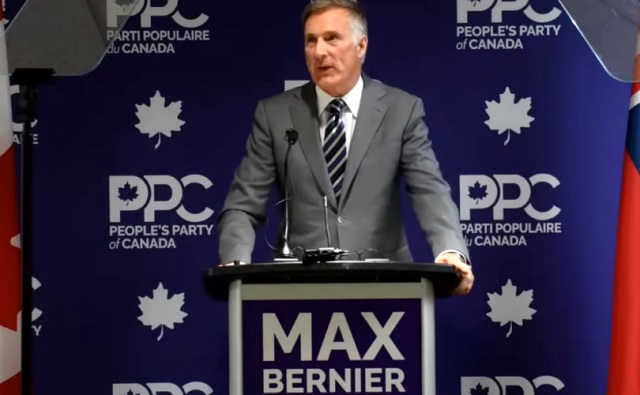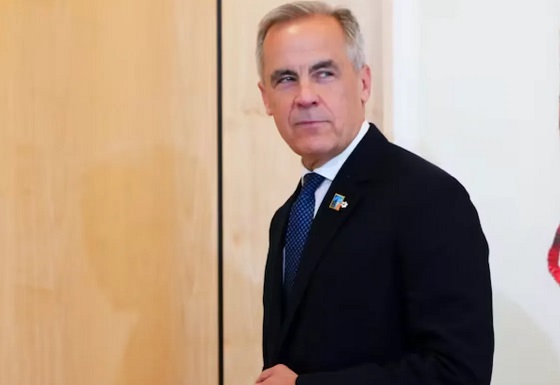armed forces
Maxime Bernier slams Trudeau gov’t for mandating tampons in male washrooms

From LifeSiteNews
Maxime Bernier accused ‘cultural marxists’ of desiring to turn as ‘many men as possible into non-binary, trans, gender-fluid, weak, effeminate sissies.’
People’s Party of Canada leader Maxime Bernier tore a page off a new federal government directive mandating feminine hygiene products in men’s bathrooms, calling it an “attack against masculinity,” and part of a “wider ideological battle” against men in an aim to turn them into “weaklings.”
“The Liberal decision to distribute tampons in men’s toilets everywhere, including on military bases, is just another step in the systematic attack against masculinity, and part of a wider ideological battle,” wrote Bernier on X (formerly Twitter) Thursday.
The Liberal decision to distribute tampons in men’s toilets everywhere, including on military bases, is just another step in the systematic attack against masculinity, and part of a wider ideological battle.
The woke far left want to destroy Western societies, which they see as… pic.twitter.com/eirnOtpfwA
— Maxime Bernier (@MaximeBernier) December 14, 2023
In his post, Bernier observed that the “far-left want to destroy Western societies, which they see as responsible for all evils in the world.”
“They’re not only busy undermining our institutions, our culture, our economy, our values, our history, our social cohesion, and the traditional family. They also want to completely destroy traditional gender identities and roles,” he noted.
Bernier has been a consistent vocal opponent of extreme gender-bending ideologies, saying there are only two “sexes” and that “common sense will prevail” in the gender debate. He has also been opposed to LGBT indoctrination in public schools. He has also called out the Conservative Party of Canada for not being vocal enough about these issues.
His commentary was brought on by a new federal mandate, which LifeSiteNews reported a few days ago, that forces all Canadian federal workplaces, including military bases, to provide what are termed “menstruation kits” in men’s bathrooms to promote “inclusivity.”
The new mandate comes into force today, December 15, as per an directive issued by Employment and Social Development Canada, which claims giving out free pads and tampons in men’s bathrooms enables “menstruating persons to take part fully in the workforce and society at large.”
Bernier noted that Canada is “throwing the baby out with the bathwater by letting the woke fanatics impose a new, unnatural and degenerate model,” when it comes to gender.
He argued that while it is “great that individuals nowadays are not coerced anymore into strictly conforming to traditional gender stereotypes,” the reality is women are “encouraged to not have children, treat all men like potential rapists, be ambitious and aggressive in their careers, and made to feel like failures if they prefer more traditional roles.”
Bernier: Cultural ‘Marxists’ want to turn men into ‘sissies” and ‘gender-fluid’ weaklings
Bernier noted how in today’s Canada, “traditionally feminine role models and identities” are being “normalized for men,” as traditional male roles are being frowned upon as “toxic” and thus somehow bad.
He observed that “human history” has shown that “strong men” have played the role of their society’s “providers and protectors,” but men today are being pushed into a corner.
“Today they [men] are not praised for their courage and selflessness, but denounced as exhibiting ‘toxic masculinity.’ It is no coincidence if the cultural Marxists have become obsessed with gender issues, and aim to brainwash and confuse our children with their sick gender ideology,” noted Bernier.
Bernier noted how the goal of the “cultural Marxists” is to turn as “many men as possible into non-binary, trans, gender-fluid, weak, effeminate sissies.”
“In short, in a world that is becoming increasingly unstable and dangerous, they want our society to disintegrate and become defenseless,” he said.
Over the past few years, there has been a noticeable push in western nations to actively promote gender ideology to young people, particularly in the United States and Canada.
The Liberal Federal government of Prime Minister Justin Trudeau is fully on board with the LGBT agenda. Recently, it pledged a whopping $100 million in funding last year for LGBT activist groups, with much of the money focused on youth and on-the-ground initiatives.
In 2017, Canada’s Senate passed what is termed the transgender rights bill. This bill adds “gender expression” and “gender identity” to Canada’s Human Rights Code and to the Criminal Code’s hate crime section.
Around the same time, Canada’s federal public servants were forced to take a mandatory feminist “gender equality” course or face unspecified consequences.
As for Bernier, he frequented many anti-COVID lockdown rallies across Canada throughout 2021 and 2022 when most provinces had in place strict COVID health rules. He was one of the few politicians to speak out against COVID mask and vaccine mandates from the start of the so-called pandemic, and one of the only to publicly announce that he never took the experimental vaccines.
armed forces
Mark Carney Thinks He’s Cinderella At The Ball

And we all pay when the dancing ends
How to explain Mark Carney’s obsession with Europe and his lack of attention to Canada’s economy and an actual budget?
Carney’s pirouette through NATO meetings, always in his custom-tailored navy blue power suits, carries the desperate whiff of an insecure, small-town outsider who has made it big but will always yearn for old-money credibility. Canada is too young a country, too dynamic and at times a bit too vulgar to claim equal status with Europe’s formerly magnificent and ancient cultures — now failed under the yoke of globalism.
Hysterical foreign policy, unchecked immigration, burgeoning censorship and massive income disparity have conquered much of the continent that many of us used to admire and were even somewhat intimidated by. But we’ve moved on. And yet Carney seems stuck, seeking approval and direction from modern Europe — a place where, for most countries, the glory days are long gone.
Carney’s irresponsible financial commitment to NATO is a reckless and unnecessary expenditure, given that many Canadians are hurting. But it allowed Carney to pick up another photo of himself glad-handing global elites to whom he just sold out his struggling citizens.
From the Globe and Mail
“Prime Minister Mark Carney has committed Canada to the biggest increase in military spending since the Second World War, part of a NATO pledge designed to address the threat of Russian expansionism and to keep Donald Trump from quitting the Western alliance.
Mr. Carney and the leaders of the 31 other member countries issued a joint statement Wednesday at The Hague saying they would raise defence-related spending to the equivalent of 5 per cent of their gross domestic product by 2035.
NATO Secretary-General Mark Rutte said the commitment means “European allies and Canada will do more of the heavy lifting” and take “greater responsibility for our shared security.”
For Canada, this will require spending an additional $50-billion to $90-billion a year – more than doubling the existing defence budget to between $110-billion and $150-billion by 2035, depending on how much the economy grows. This year Ottawa’s defence-related spending is due to top $62-billion.”
You’ll note that spending money we don’t have in order to keep President Trump happy is hardly an elbows up moment, especially given that the pledge followed Carney’s embarrassing interactions with Trump at the G7. I’m all for diplomacy but sick to my teeth of Carney’s two-faced approach to everything. There is no objective truth to anything our prime minister touches. Watch the first few minutes of the video below.

The portents are bad. This from the Globe:
We are poorer than we think. Canadians running their retirement numbers are shining light in the dark corners of household finances in this country. The sums leave many “anxious, fearful and sad about their finances,” according to a Healthcare of Ontario Pension Plan survey recently reported in these pages.
Fifty-two per cent of us worry a lot about our personal finances. Fifty per cent feel frustrated, 47 per cent feel emotionally drained and 43 per cent feel depressed. There is not one survey indicator to suggest Canadians have made financial progress in 2025 compared with 2024.
The video below is a basic “F”- you to Canadians from a Prime Minister who smirks and roles his eyes when questioned about his inept money management.
He did spill the beans to CNN with this unsettling revelation about the staggering numbers we are talking about:
Signing on to NATO’s new defence spending target could cost the federal treasury up to $150 billion a year, Prime Minister Mark Carney said Tuesday in advance of the Western military alliance’s annual summit.
The prime minister made the comments in an interview with CNN International.
“It is a lot of money,” Carney said.
This guy was a banker?
We are witnessing the political equivalent of a vain woman who blows her entire paycheque to look good for an aspirational event even though she can’t afford food or rent. Yes, she sparkled for a moment, but in reality her domaine is crumbling. All she has left are the photographs of her glittery night. Our Prime Minister is collecting his own album of power-proximity photos he can use to wallpaper over his failures as our economy collapses.
The glass slipper doesn’t fit.
Trish Wood is Critical is a reader-supported publication.
To receive new posts and support my work, consider becoming a free or paid subscriber.
Invite your friends and earn rewards
armed forces
It’s not enough to just make military commitments—we must also execute them

From the Fraser Institute
By Jake Fuss and Grady Munro
To reach 2 per cent of GDP this year, the federal government is committing an additional $9.3 billion towards the military budget. Moreover, to reach 3.5 per cent of GDP by 2035, it’s estimated the government will need to raise yearly spending by an additional $50 billion—effectively doubling the annual defence budget from $62.7 billion to approximately $110 billion.
As part of this year’s NATO summit, Canada and its allies committed to increase annual military spending to reach 5 per cent of gross domestic product (GDP) by 2035. While this commitment—and the government’s recent push to meet the previous spending target of 2 per cent of GDP—are important steps in fulfilling Canada’s obligations to the alliance, there are major challenges the federal government will need to overcome to execute these plans.
Since 2014, members of the North Atlantic Treaty Organization (NATO) have committed to spend at least 2 per cent of GDP (a measure of overall economic output) on national defence. Canada had long-failed to fulfill this commitment, to the ire of our allies, until the Carney government recently announced a $9.3 billion boost to defence spending (up to a total of $62.7 billion) that will get us to 2 per cent of GDP during the 2025/26 fiscal year.
However, just as Canada reached the old target, the goal posts have now moved. As part of the 2025 NATO summit, alliance members (including Canada) committed to reach an increased spending target of 5 per cent of GDP in 10 years. The new target is made up of two components: core military spending equivalent to 3.5 per cent of GDP, and another 1.5 per cent of GDP for other defence-related spending.
National defence is a core function of the federal government and the Carney government deserves credit for prioritizing its NATO commitments given that past governments of different political stripes have failed to do so. Moreover, the government is ensuring that Canada remains in step with its allies in an increasingly dangerous world.
However, there are major challenges that arise once you consider how the government will execute these commitments.
First, both the announcement that Canada will reach 2 per cent of GDP in military spending this fiscal year, and the future commitment to spend up to 3.5 per cent of GDP on defence by 2035, represent major fiscal commitments that Canada’s budget cannot simply absorb in its current state.
To reach 2 per cent of GDP this year, the federal government is committing an additional $9.3 billion towards the military budget. Moreover, to reach 3.5 per cent of GDP by 2035, it’s estimated the government will need to raise yearly spending by an additional $50 billion—effectively doubling the annual defence budget from $62.7 billion to approximately $110 billion. However, based on the last official federal fiscal update, the federal government already plans to run an annual deficit this year—meaning it spends more than it collects in revenue—numbering in the tens of billions, and will continue running large deficits for the foreseeable future.
Given this poor state of finances, the government is left with three main options to fund increased military spending: raise taxes, borrow the money, or cut spending in other areas.
The first two options are non-starters. Canadian families already struggle under a tax burden that sees them spend more on taxes than on food, shelter, and clothing combined. Moreover, raising taxes inhibits economic growth and the prosperity of Canadians by reducing the incentives to work, save, invest, or start a business.
Borrowing the money to fund this new defence spending will put future generations of Canadians in a precarious situation. When governments borrow money and accumulate debt (total federal debt is expected to reach $2.3 trillion in 2025-26), the burden of this debt falls squarely on the backs of Canadians—likely in the form of higher taxes in the future. Put differently, each dollar we borrow today must be paid back by more than a dollar in higher taxes tomorrow.
This leaves cutting spending elsewhere as the best option, but one that requires the government to substantially readjusts its priorities. The federal government devotes considerable spending towards areas that are not within its core responsibilities and which shouldn’t have federal involvement in the first place. For instance, the previous government launched three major initiatives to provide national dental care, national pharmacare and national daycare, despite the fact that all three areas fall squarely under provincial jurisdiction. Instead of continuing to fund federal overreach, the Carney government should divert spending back to the core function of national defence. Further savings can be found by reducing the number of bureaucrats, eliminating corporate welfare, dropping electric vehicle subsidies, and many other mechanisms.
There is a fourth option by which the government could fund increased defence spending, which is to increase the economic growth rate within Canada and enjoy higher overall revenues. The problem is Canada has long-suffered a weak economy that will remain stagnant unless the government fundamentally changes its approach to tax and regulatory policy.
Even if the Carney government is able to successfully adjust spending priorities to account for new military funding, there are further issues that may inhibit money from being spent effectively.
It is a well-documented problem that military spending in Canada is often poorly executed. A series of reports from the auditor general in recent years have highlighted issues with the readiness of Canada’s fighter force, delays in supplying the military with necessary materials (e.g. spare parts, uniforms, or rations), as well as delays in delivering combat and non-combat ships needed to fulfill domestic and international obligations. All three of these cases represent instances in which poor planning and issues with procurement and supply chains) are preventing government funding from translating into timely and effective military outcomes.
The Carney government has recently made major commitments to increase military funding to fulfill Canada’s NATO obligations. While this is a step in the right direction, it’s not enough to simply make the commitments, the government must execute them as well.
-

 Automotive2 days ago
Automotive2 days agoElectric vehicle sales are falling hard in BC, and it is time to recognize reality.
-

 Energy2 days ago
Energy2 days agoChina undermining American energy independence, report says
-

 Business2 days ago
Business2 days agoTrump on Canada tariff deadline: ‘We can do whatever we want’
-

 Business2 days ago
Business2 days agoEurope backs off greenwashing rules — Canada should take note
-

 Automotive2 days ago
Automotive2 days agoPower Struggle: Electric vehicles and reality
-

 Alberta9 hours ago
Alberta9 hours agoAlberta judge sides with LGBT activists, allows ‘gender transitions’ for kids to continue
-

 Business16 hours ago
Business16 hours agoCanada Caves: Carney ditches digital services tax after criticism from Trump
-

 Crime15 hours ago
Crime15 hours agoSuspected ambush leaves two firefighters dead in Idaho











